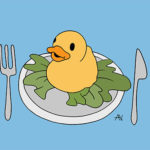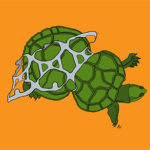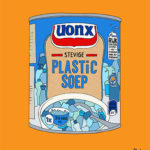Plastic diet
Microplastic particles in the ocean look like algae and single-celled organisms, so fish don’t hesitate to eat them. The tiny pieces of plastic can also end up on the ocean floor, where they are eaten by animals living there, such as worms or sea cucumbers 1.
Plastic in the food chain

MMicroplastic is eaten by tiny animals, such as shrimp, which are then eaten by larger animals. As that process continues, the tiny pieces of plastic accumulate in the food chain, where they can eventually reach our dinner tables.
Research has shown that even microscopic organisms at the bottom of the food chainA food chain is the way in which we order nature by asking the question: who eats who? The food chain starts with the smallest animals: for example plankton. Small animals are eaten by somewhat larger species (like shrimps). They are being eaten by larger animals, and so on., such as plankton, eat plastic as well2. The plastic in their stomachs takes up space, so the organisms have less room for real food. And when they are eaten by larger animals, the plastic in their bodies gets passed on 3.
Let’s look at a shrimp, for example. Shrimp can mistake pieces of microplastic for algae, and swallow them as food. When the shrimp is then eaten by a fish, the plastic ends up in the fishes’ stomach as well. That fish can then be eaten by larger fish. In the process, the plastic spreads throughout the food chain, where it eventually ends up on our plate.
‘Not a single animal species has gone extinct due to plastic pollution’
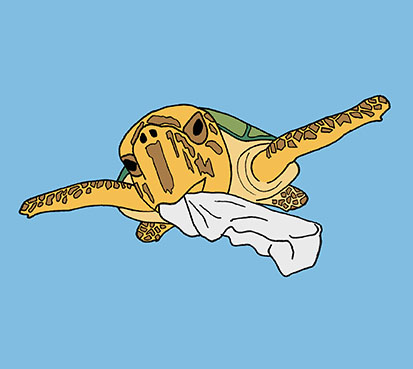
Did you know that… 100% of the sea turtles plastic have plastic in their stomachs?
We know much more about plastic in the stomachs of birds, turtles, and sea mammals than we do about plastic in the stomachs of animals at the bottom of the food chain. It is true that 100% of all sea turtles, 59% of all whales, 36% of all seals, and 40% of all marine birds studied have had plastic in their stomachs 8. But although many animals do eat plastic, not many of them die from it. As far as we know, there are no animal species on the verge of extinction due to eating plastic waste.
[well size=”sm”]
Plastic as fish food
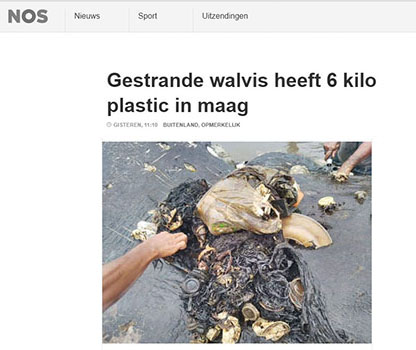
On 19 November, a sperm whale beached on an Indonesian island with almost six kilogrammes of plastic in its stomach. The 9.5 meter-long mammal was found on a beach on the island of Kapota, near Sulawesi.
Plastic is also found in the stomachs of fish, but we don’t know how unhealthy it is for the fish4,5,6. Scientists believe that eating a lot of microplastic over a long time frame is bad for the animal’s health, because if their stomachs are full of microplastic, there is less room for real food. The fish can die of starvation, even though it doesn’t feel hungry7. That was also the case for the whale beached on the Indonesian coast. The NOS news article reported that the sea mammal had 6 kilogrammes of plastic in its stomach!
[/well]
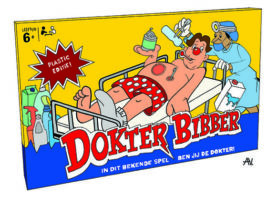
How much plastic do we have in our bodies?
Do we have plastic in our stomachs too?
Some animals known to have plastic in their stomachs, such as mussels, oysters, and certain fish, are also eaten by humans. Could the plastic inside these animals also end up inside our stomachs?
[collapsibles]
[collapse title= Sources]
1 Thompson, R. C., Olsen, Y., Mitchell, R. P., Davis, A., Rowland, S. J., John, A. W., … & Russell, A. E. (2004). Lost at sea: where is all the plastic?. Science, 304(5672), 838-838.
2 Cole, M., Lindeque, P., Fileman, E., Halsband, C., Goodhead, R., Moger, J., & Galloway, T. S. (2013). Microplastic ingestion by zooplankton. Environmental science & technology, 47(12), 6646-6655.
3 Lee, K. W., Shim, W. J., Kwon, O. Y., & Kang, J. H. (2013). Size-dependent effects of micro polystyrene particles in the marine copepod Tigriopus japonicus. Environmental science & technology, 47(19), 11278-11283.
4 Foekema, E. M., De Gruijter, C., Mergia, M. T., van Franeker, J. A., Murk, A. J., & Koelmans, A. A. (2013). Plastic in north sea fish. Environmental science & technology, 47(15), 8818-8824.
5 Davison, P., & Asch, R. G. (2011). Plastic ingestion by mesopelagic fishes in the North Pacific Subtropical Gyre. Marine Ecology Progress Series, 432, 173-180.
6 Rummel, C. D., Löder, M. G., Fricke, N. F., Lang, T., Griebeler, E. M., Janke, M., & Gerdts, G. (2016). Plastic ingestion by pelagic and demersal fish from the North Sea and Baltic Sea. Marine pollution bulletin, 102(1), 134-141.
7 Wright, S. L., Thompson, R. C., & Galloway, T. S. (2013). The physical impacts of microplastics on marine organisms: a review. Environmental pollution, 178, 483-492.
8 Kühn, S., Rebolledo, E. L. B., & van Franeker, J. A. (2015). Deleterious effects of litter on marine life. In Marine anthropogenic litter (pp. 75-116). Springer, Cham.
[/collapse]
More interesting info..
